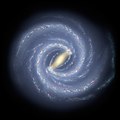
The following outline is provided as an overview of and topical guide to astronomy:
Contents
- Nature of astronomy
- Branches
- History
- Basic astronomical phenomena
- Astronomical objects
- Solar System
- Exoplanets
- Stars and stellar objects
- Constellations
- Clusters and nebulae
- Galaxies
- Cosmology
- Space exploration
- Organizations
- Books and publications
- Astronomers
- See also
- References
- External links
Astronomy – studies the universe beyond Earth, including its formation and development, and the evolution, physics, chemistry, meteorology, and motion of celestial objects (such as galaxies, planets, etc.) and phenomena that originate outside the atmosphere of Earth (such as the cosmic background radiation). Astronomy also intersects with biology, as astrobiology, studying potential life throughout the universe.



